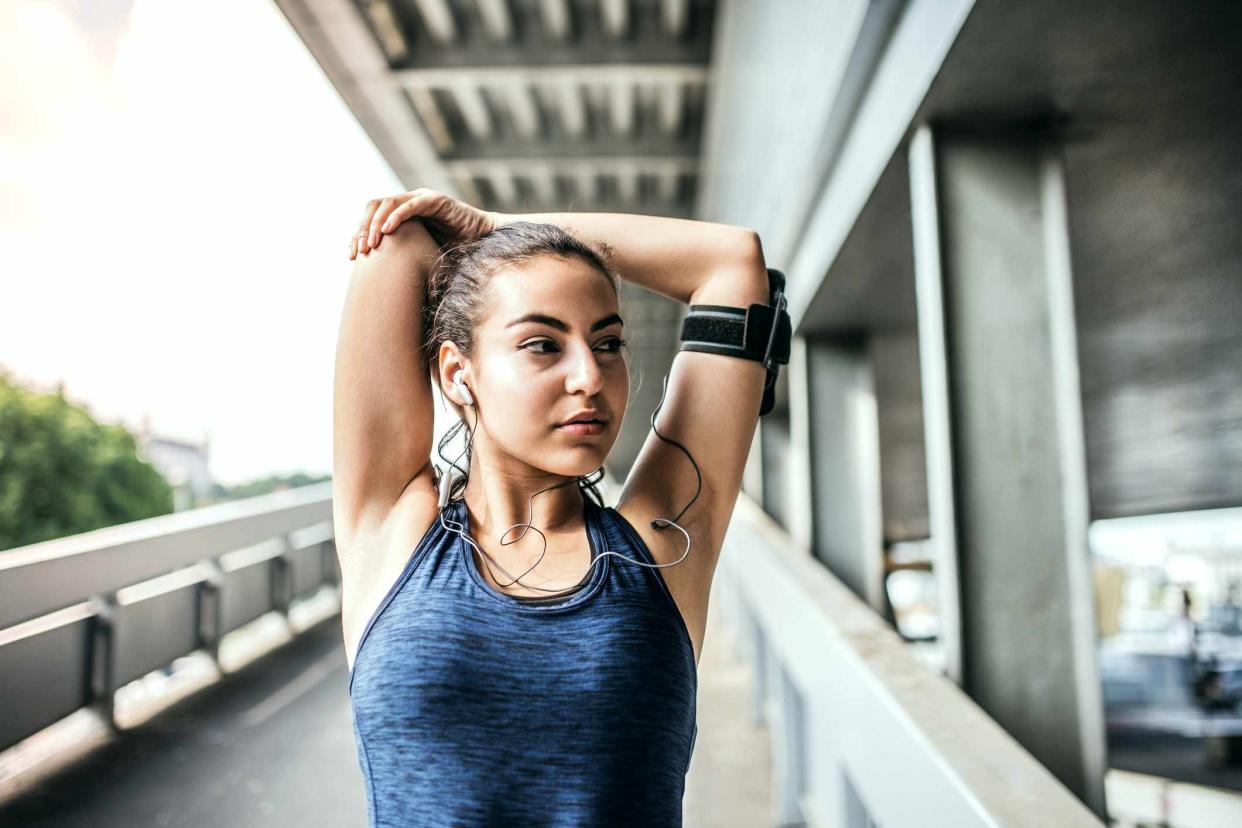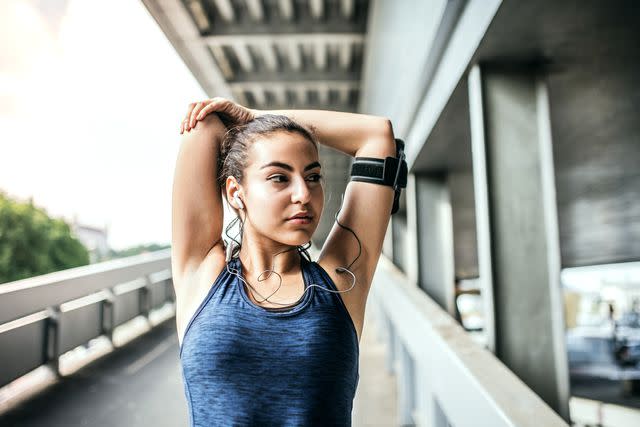Your Total Guide to Audio Workouts Like Gold's Amp and BeatActive

Halfpoint Images / Getty Images
Fact checked by Adah Chung
The consumption of audio content is on the rise, with the Association of American Publishers reporting that nearly 1 in 5 Americans listened to audiobooks in 2018. Pew Research Center's "State of the News" report also notes that podcast and online radio listening have been steadily increasing year-over-year.
These increases are linked to the widespread use of smartphones and the corresponding technology that enables users to access streaming content whenever they want, wherever they are. So it should come as no surprise that audio workouts are also making their way into the mainstream.
But the use of audio cues for fitness instruction is actually a bit of a break from traditional fitness content. While workout music has long been linked to motivation and exercise performance, fitness instruction has largely been viewed as a visual experience. This makes sense: Exercisers appreciate seeing an instructor or expert demonstrate a movement before attempting the movement themselves.
Takeaway
For individuals who feel comfortable performing exercises without a visual cue, audio workouts may be a nice alternative to more traditional workout formats.

Benefits of Audio Workouts
Audio workouts aren't ideal for every situation. If you love dance-based fitness or intricately choreographed group exercise classes, it's going to be hard to achieve the same caliber of workout using nothing but audio cues. But if you prefer to lift weights, direct your own high-intensity interval routines, or head outside for long-distance endurance training, audio workouts could be a game-changer.
No Dependence on Visual Cues
One of the biggest benefits of audio-based training is that it removes the crutch of visual cues. If you're taking a class or following an online video, it can be easy to get so caught up in watching the instructor that you fail to tune into your own movements. This could open you up to injury.
This is particularly true in larger, class-based settings where it's possible to get distracted by the movements of your instructor and other class attendees. If you're familiar with the exercises, and you know how to perform them correctly, there's no reason to spend most of your workout focused on an instructor's movements.
Takeaway
Audio workouts provide instruction without the distraction of visual cues, making it easier to focus on your own proper form.
Enhanced Solo Training
Audio workouts are also perfect for solo exercise, such as running, rowing, elliptical training, and cycling. While you may not feel the need to enlist an instructor when you hop on a cardio machine, having a coach available to motivate you and offer instruction could encourage you to work harder.
With audio-guided workouts, you receive personal coaching delivered straight to your ear. You'll receive instructions on when to increase or decrease your tempo and pace without the cost of an actual coach.
Takeaway
Audio-guided cueing could motivate you to push harder while training, ultimately helping you attain your next personal record.
Pre-Planned Routines
It's not always easy to know what to do when you get to the gym. Without a program to follow or a personal trainer to guide you, you may feel un-anchored, floating aimlessly from exercise to exercise without intention.
When you use an audio workout, you can select the style of workout you want to perform, then simply follow the instruction provided. And because audio workouts are usually developed by certified coaches and trainers, you can feel confident the routine you're following is appropriate and sound.
Low-Cost or Free
Audio workouts offer the guidance of a fitness expert at a fraction of the cost of personal training or coaching. If you're on a tight budget, apps, podcasts, and other audio-training solutions can help you bridge the gap in your knowledge at a budget-friendly price.
Drawbacks of Audio Workouts
While there are certain situations where audio workouts are appropriate (and even preferential) to visual training, there are drawbacks to consider.
Less Skilled Instructors
Great fitness coaches are great instructors. They know how and when to provide instruction and how to describe what an exercise should look and feel like. They're also good at keeping count and offering encouragement.
While cueing is important in visual workouts, it's downright essential during audio workouts. If you follow a routine led by a poor instructor, the cues provided could interfere with your understanding of the exercise or program, limiting its benefits.
Challenging for Beginners
There's no way around it: If you're unfamiliar with how an exercise should look, even the best audio cues in the world probably won't help you do it correctly. For instance, unless you already know what a revolved side angle pose is supposed to look like, it's going to be hard to follow a yoga instructor's audio cues to get the pose exactly right (especially if the workout is a fast-paced flow).
Takeaway
If you're new to a type of workout that requires close attention to proper form, you might be better off sticking to visual classes and instruction until you master the form of frequently used exercises.
No Personalization
While there are a few exceptions, most audio workouts lack personalization. This means that if you have an injury and can't do squats, but your audio program repeatedly asks you to do squats, you're in charge of altering your own workout.
One way to personalize your workout, audio or live, is by wearing one of these best functional and flattering running skirts.
Takeaway
Audio routines are best for intermediate- to advanced-level exercisers who already know proper form and are comfortable following audio cues. They're also good for individuals engaged in endurance training, who need a little extra motivation to push themselves during a pace- or tempo-based routine.
Apps and Downloads
Audio training through apps and downloads has been around for some time, particularly in relation to endurance-based run training, but if you haven't checked out new apps in a few years, it's worth doing. There are now programs for almost every type of workout.
Gold's Amp
The Gold's Amp app, available on iTunes and Google Play, features well over 100 custom workouts developed by Gold's Gym experts. These workouts are high-quality and varied, ranging from outdoor runs to bodyweight workouts, stretching, stair climbing, and rowing routines.
Users can sort workouts by intensity level, trainer, time, and the focus of the routine, and they can match their chosen routine to one of the thousands of DJ-mixed playlists (from more than 40 music genres) that exist in the Gold's Amp music library. Gold's Amp provides almost limitless variety in instruction and music to keep users engaged, motivated, and focused while working out.
Beatactive
Beatactive, which focuses primarily on bodyweight workouts, combines audio cueing with custom-designed, electronic dance music (EDM) that's perfectly synched to the tempo and intensity of the cued exercises. Workouts are typically designed in a circuit format for a quick, effective, cardio and strength training combination.
Motion Traxx
Motion Traxx features custom music and audio coaching, but this app's focus is on cardio training workouts, including those on the treadmill, elliptical, and bike. Available on iTunes and Google Play, the audio cueing is offered by nationally recognized trainers like Jessica Smith, Amy Dixon, and Paul Katami.
Aaptiv
Aaptiv is another app that combines music and audio coaching, but it offers more wide-ranging workout options. You can select everything from a treadmill workout to yoga, strength training, or stretching. Also, the music isn't custom-created but includes tunes you already know, straight from the radio. Aaptiv is available on iTunes and Google Play.
Audio Wearables
Audio wearables combine wearable equipment, such as heart rate monitors, earbuds, and foot pods, with audio cues based on real-time biofeedback. This means that in addition to receiving audio cueing for your workout routine, you'll also receive information on how hard you're working, whether you should increase your intensity, or, based on GPS, how far you've traveled.
PEAR Sports
PEAR Sports has been around for a number of years, and it has adapted and improved its audio coaching system with time. It now offers hundreds of programs designed by high-level coaches for practically all activities and workouts, including strength training, running, stand up paddleboarding, beach volleyball, and foam rolling. PEAR wearables include headphones and a heart rate monitor, and their downloadable app is available on iTunes and Google Play.
Jabra
The Jabra Sport Coach Special Edition earbuds have a TrackFit Motion Sensor embedded inside that tracks your motion, automatically counting your reps (just like a trainer!) while gauging distance traveled and steps taken. The corresponding app (available on iTunes and Google Play) provides pre-programmed workouts you can follow, but you can also design your own routine, then follow it seamlessly as you listen to the audio cues through your earbuds.
Vi
Touting itself as the first artificial intelligence personal trainer, Vi tracks and monitors your physical fitness throughout the day, providing you real-time feedback on your activity, synching with your personal fitness goals to encourage you to meet them. The corresponding app is available on iTunes and Google Play.
Podcasts
While workout and training podcasts typically just talk about exercise, there are a few exceptions, particularly when it comes to yoga. If you're an intermediate-level yogi who's familiar with most poses and proper form, try the free practices available through podcast platforms. For instance, the Yoga Download 20 Minute Yoga Sessions podcast has hundreds of short, high-quality programs.

